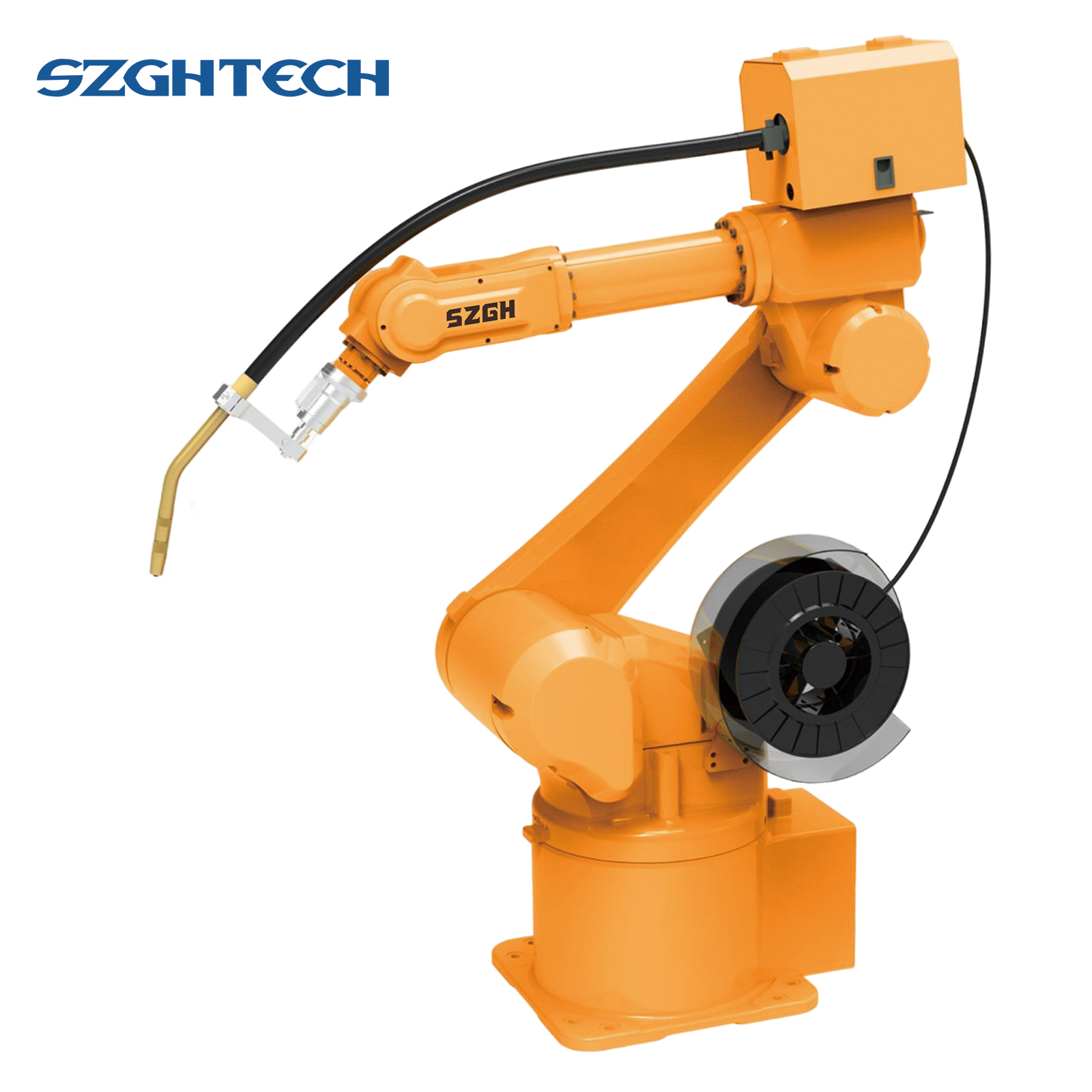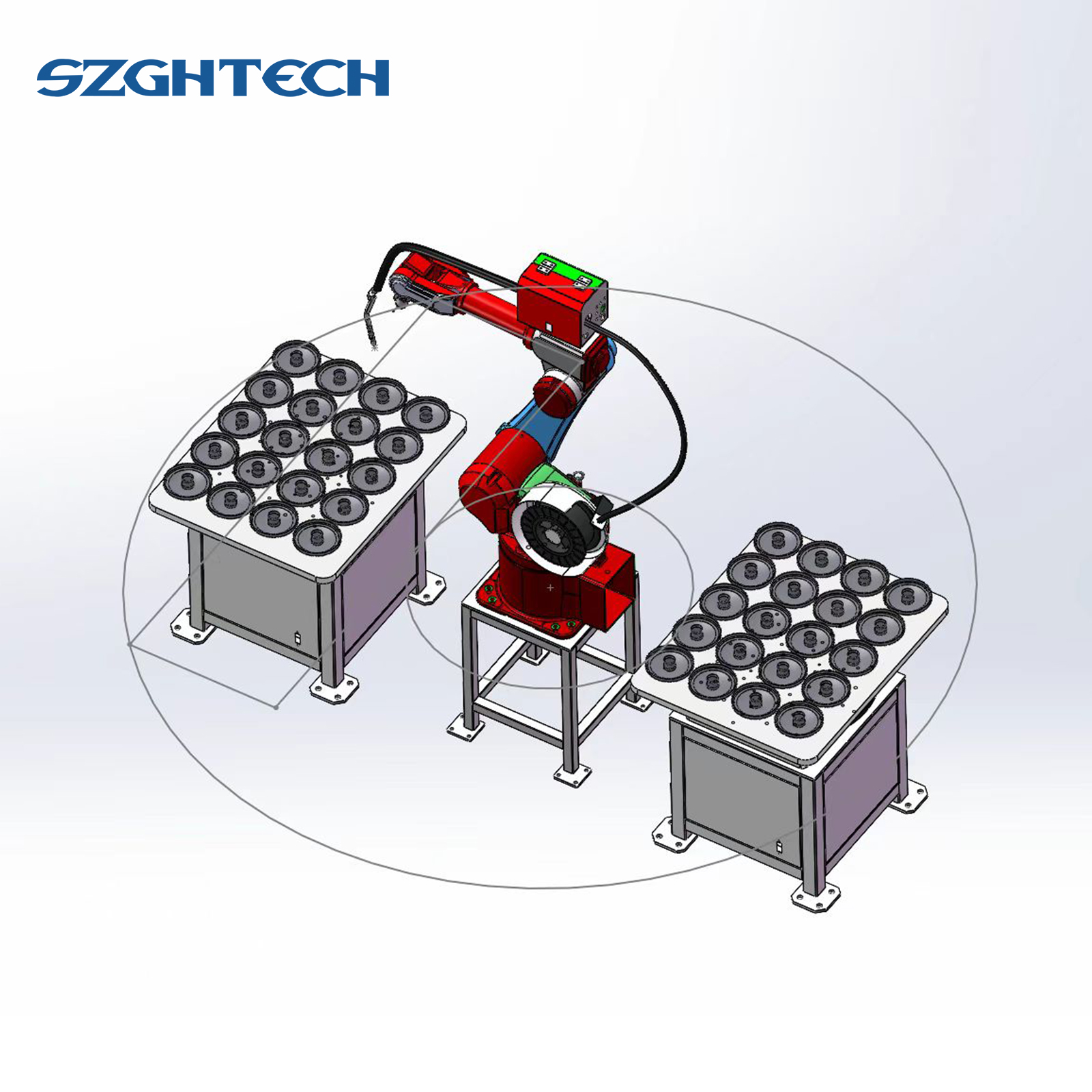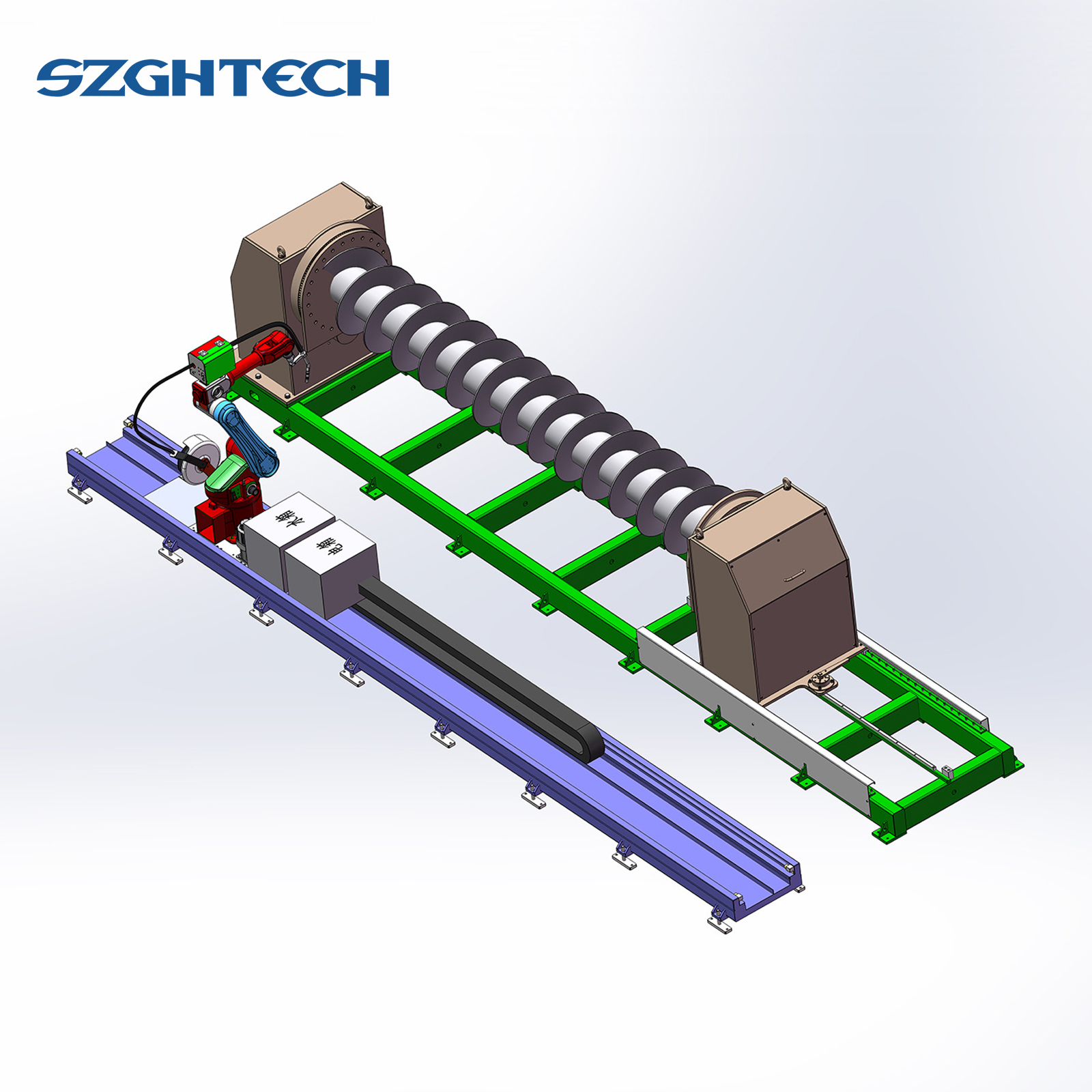I. Core Advantages of Welding Robots
Welding robots outperform manual welding in precision, consistency, and reliability, addressing long-standing challenges in welding processes. Their advantages are rooted in advanced automation technology and intelligent control systems, as detailed below:

1. High-Precision Trajectory Control Ensures Consistent Welding Position
Equipped with high-performance servo motors and advanced motion control algorithms, welding robots achieve micron-level accuracy in trajectory planning and execution. Unlike manual welders, who may struggle with hand tremors, visual fatigue, or inconsistent hand movements—especially when working on complex 3D weld seams—robots follow preprogrammed paths with unwavering consistency. For instance, in the welding of automotive chassis components (e.g., frame joints and suspension brackets), robots can maintain a welding position deviation of less than ±0.03mm, ensuring that every weld aligns perfectly with design specifications. Many high-end models also integrate vision-guided systems: cameras or laser sensors scan the workpiece in real time, detecting minor positional errors (such as slight shifts in workpiece placement) and dynamically adjusting the robot’s trajectory. This adaptability further guarantees consistent welding positions, even in batch production where subtle variations in workpiece positioning may occur.
2. Constant Welding Parameter Output Avoids Fluctuations During the Welding Process
Welding quality depends heavily on stable parameters, including welding current, voltage, wire feed speed, and shielding gas flow. Manual welding is prone to parameter fluctuations: a welder’s physical fatigue (after hours of work), emotional state, or even minor adjustments to hand pressure can cause current to spike or drop, leading to defects like porosity, incomplete fusion, or slag inclusion. In contrast, welding robots use dedicated welding controllers to lock parameters at preset values, ensuring zero manual interference. For example, in Metal Inert Gas (MIG) welding of carbon steel sheets, robots maintain current fluctuations within ±1A, voltage fluctuations within ±0.5V, and wire feed speed variations below ±0.1m/min. This stability ensures uniform weld penetration and bead width across every section of the weld. Tests show that consistent parameter output reduces the rate of parameter-related defects by over 80% compared to manual welding, significantly improving the reliability of weld mechanical properties (e.g., tensile strength and impact toughness).

3. Automatic Compensation for Minor Errors Improves Overall Yield
In real-world production, minor errors are inevitable: workpiece machining tolerances, wear on fixtures, or thermal deformation during welding can cause deviations between the actual workpiece size and its design dimensions. Left unaddressed, these errors lead to poor weld alignment, incomplete fusion, or even scrapped parts. Welding robots solve this problem with automatic error compensation capabilities, leveraging sensors (e.g., force sensors, laser displacement sensors) to detect deviations in real time. For example, when welding thick steel plates (20mm or thicker), thermal input from the welding arc may cause the workpiece to expand or warp, altering the gap between the two plates being joined. A laser displacement sensor mounted on the robot’s end effector detects this gap change; the robot then adjusts its wire feed speed and welding current accordingly—increasing current to fill a wider gap, for instance—ensuring complete fusion without burn-through or underfill. This proactive compensation reduces the number of defective parts caused by minor errors by 30–50%, directly boosting overall production yield, particularly in high-volume manufacturing (e.g., construction machinery components).

4. Reduced Scrap and Rework Rates Drive Overall Product Quality Improvement
High-performance welding robots, by combining precision trajectory control, stable parameter output, and automatic error compensation, fundamentally minimize scrap and rework caused by poor welding. Manual welding typically results in a scrap rate of 5–10% and a rework rate of 8–12%: defective parts may be scrapped entirely, or require time-consuming rework (e.g., grinding away flawed welds and re-welding), which wastes materials, labor, and time—even risking secondary damage to the workpiece. Welding robots, however, cut scrap rates to below 1% and rework rates to less than 0.5%. Take the welding of excavator boom arms (a critical structural component) as an example: before adopting robots, a manufacturer faced a 7% scrap rate due to weld cracks and incomplete fusion; after switching to robots, the scrap rate dropped to 0.8%, and rework time decreased by 90%. This not only lowers production costs but also shortens lead times, as fewer parts need to be reprocessed. Ultimately, the reduction in scrap and rework translates to a significant leap .
ll product quality, meeting stricter industry standards (e.g., ISO 3834 for welding quality management).
5. Stable, Continuous, and High-Speed Operation Overcomes Manual Efficiency Limitations
Manual welding is constrained by human physiological limits: welders require breaks for rest, meals, and recovery from fatigue, and their speed decreases as they tire—especially during long shifts. Welding robots eliminate these constraints, operating stably, continuously, and at high speeds. First, robots can run 24/7 with only short downtime for regular maintenance (e.g., cleaning the torch or replacing consumables), increasing effective operating time from 70% (for manual 3-shift operations) to over 90%. Second, their welding speed far exceeds manual capabilities: for thin stainless steel sheets (1–2mm thick), manual MIG welding typically achieves speeds of 0.3–0.5m/min, while robots reach 0.8–1.2m/min—a nearly 2x efficiency gain. Third, robots never experience fatigue or loss of focus: even during overnight or weekend shifts, they maintain consistent speed and quality. A case study of a motorcycle frame manufacturer showed that introducing 10 welding robots increased daily production from 300 frames (with 30 manual welders) to 550 frames (with only 5 operators monitoring the robots), doubling overall efficiency.
II. Key Drivers for Productivity Improvement with Welding Robots
The primary goal of adopting welding robots is to boost productivity, which hinges on optimizing time utilization, standardizing processes, and reducing labor dependency. The following factors are critical to unlocking productivity gains:
1. No Need for Rest Enables Around-the-Clock Efficient Operation
Traditional manual welding relies on 3-shift rotations to maximize output, but even this setup includes unavoidable downtime: shift handovers (15–20 minutes per shift), worker breaks (e.g., 2 15-minute breaks per 8-hour shift), and absences due to illness or vacation. These gaps reduce actual working time to ~16 hours per day (70% of 24 hours). Welding robots, by contrast, require no rest: with automated material handling systems (e.g., conveyor belts or robotic loaders/unloaders) to feed workpieces, they operate continuously for 22–23 hours daily. For example, a manufacturer of electrical enclosures replaced 6 manual welders with 2 robots: the robots ran 23 hours/day (with 1 hour for maintenance), producing 450 enclosures daily—compared to 280 enclosures when using manual labor. The 60% productivity increase stemmed directly from eliminating rest-related downtime and leveraging overnight/weekend operation.
2. Standardized Operating Procedures Reduce Process Changeover Time
Manual welding processes are highly dependent on individual skill: different welders may use slightly different sequences (e.g., welding order of multiple seams), parameter settings, or workpiece clamping methods. When switching between product models (e.g., from welding a small pipe to a large tank), workers must re-learn processes, adjust fixtures, and test parameters—leading to changeover times of 30–60 minutes. Welding robots use standardized, preprogrammed procedures: every step (workpiece positioning, torch angle adjustment, parameter selection, post-weld inspection) is digitized and stored in the robot’s controller. When changing models, operators simply select the corresponding program from a menu; the robot automatically adjusts its trajectory, parameters, and fixture settings. For example, in a factory producing 5 types of steel brackets, robot changeover time between models is just 5–10 minutes—80% faster than manual changeovers. This efficiency is particularly valuable for high-mix, low-volume production, where frequent model changes are common.
III. Three Critical Factors for Selecting the Right Welding Robot
Choosing the correct welding robot is essential to maximizing its benefits; a mismatched robot may fail to meet production needs or lead to unnecessary costs. The following three factors are critical for informed selection:
1. Match Welding Process Requirements
Welding processes, workpiece materials, and thicknesses demand different robot capabilities. Ignoring these differences can result in subpar weld quality or underutilized equipment.
Welding Process Compatibility: Different processes (MIG, TIG, laser welding, submerged arc welding) require specialized robot features. For example, laser welding demands ultra-high repeatability (±0.02mm or better) and fast dynamic response to ensure precise laser beam alignment; submerged arc welding requires robots with high payload capacity (10kg or more) to support heavy torches and wire feed systems. Robots must also have compatible interfaces for process-specific equipment (e.g., TIG welding power sources or laser generators).
Workpiece Material Adaptability: Materials like aluminum, titanium, and stainless steel have unique welding needs. Aluminum is prone to porosity and thermal cracking, so robots for aluminum welding must integrate pulse welding power sources and precise wire feed control to reduce heat input. Titanium requires ultra-pure shielding gas (99.999% argon) to prevent oxidation, so robots should include high-precision gas flow regulators.
Workpiece Thickness and Weld Specification: Thicker materials (e.g., 20mm+ carbon steel) require higher welding power and heavier torches, so robots need sufficient payload capacity (often 15–20kg). Thin materials (e.g., 1mm stainless steel) demand finer motion control to avoid burn-through, so robots with high repeatability (±0.03mm) are preferred. Additionally, the robot’s reach must cover all weld positions: for large workpieces (e.g., ship hull sections), a robot with a 2.5m+ arm span may be necessary.
2. Prioritize the Robot’s Repeatability
Repeatability—defined as the robot’s ability to return to the same position repeatedly—is a non-negotiable for welding quality. Even small deviations in torch position can misalign the weld, leading to defects like incomplete fusion or uneven bead shape.
Long-Term Repeatability Stability: Some low-quality robots lose precision over time due to wear on components like ball screws or harmonic drives. To avoid this, select robots built with high-grade materials (e.g., hardened steel for gears) and advanced lubrication systems. Reputable manufacturers also provide calibration services to maintain repeatability over the robot’s lifespan (5–10 years).
Verification Methods: Before purchasing, request on-site tests: have the robot perform 100 repeated movements to a target position, then use a laser tracker to measure deviations. This ensures the robot meets its advertised repeatability claims.
3. Choose a Reliable Brand and Comprehensive Service System
Welding robots are long-term investments (typically 5–10 years), so brand reliability and after-sales support directly impact operational stability and total cost of ownership.
Brand Reliability: Established brands (e.g., FANUC, YASKAWA, KUKA, ABB for international models; EFORT, SIASUN for domestic Chinese models) have decades of experience in welding automation. They use mature designs, rigorous quality control, and tested components (e.g., servo systems from Siemens or YASKAWA), resulting in lower failure rates (often <2% per year) and longer lifespans. These brands also offer broader compatibility with third-party equipment (e.g., welding power sources, sensors).
Comprehensive Service Support:
Pre-Sales Services: Reputable suppliers provide customized solutions: they assess your production needs (e.g., material, throughput, space) to recommend the right robot model, layout, and supporting equipment (e.g., fixtures, safety guards).
During-Sales Services: Suppliers should handle on-site installation, commissioning, and operator training. Training should cover basic operation, programming, and troubleshooting to ensure your team can use the robot effectively.
After-Sales Services: Look for 24/7 technical support (hotlines or online portals) and local service centers: a response time of <4 hours and on-site repair within 24 hours minimizes downtime. Suppliers should also maintain a stock of critical spare parts (e.g., torches, servo motors) with delivery times of <3 days.
Value-Added Services: Many brands offer remote monitoring (to track robot performance and predict maintenance needs) and upgrade services (e.g., adding vision systems or optimizing programs) to extend the robot’s functionality as your needs evolve.
Robot manufacturers from all over the world are welcome to consult with SZGH and discuss robot solutions together!

